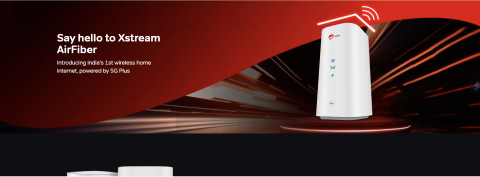Airtel offers Xstream AirFiber fixed-wireless access 5G Service with 100 Mbps plan
Bharti Airtel has launched 5G fixed-wireless access (FWA) with high speed and better connectivity for devices via Wi-Fi 6 technology. The Airtel Xstream AirFiber device will offer faster connectivity and 64 devices can connect to the device for fast internet access. Airtel has launched Airtel Xstream AirFiber with affordable Rs 799 per month plan. The service has been launched in Mumbai and New Delhi by Airtel, in a first for any Indian telecom company.
Airtel has been slow in launching 5G network across India but the company has been picking up pace. Jio offered 5G services as free upgrade for its clients in many segments. Airtel announced today that the company has plans to launch Airtel Xstream AirFiber in more cities across India in coming months. Consumers can opt for Airtel Xstream AirFiber service by paying a refundable deposit of Rs 2500. The cost per month for the plan would be Rs 799.
Airtel has planned more capital expenditure this year to improve its 5G network and to increase coverage area. Announcing the service, Airtel informed, “It will address the last mile connectivity issue in both rural and urban India where access to fiber infrastructure is a challenge. While fiber to the home will always define the best experience of Wi-Fi at home, AirFiber helps bridge the experience gap for everyone else. Today, we are delighted to launch Xstream AirFiber for consumers in Delhi and Mumbai with a pan-India rollout planned soon.”
The need for Wi-Fi at home has grown exponentially in the past 3-4 years. With fiber to home connecting only 34 million households till date, there is a strong potential for growth in this segment. Airtel is aiming to improve its average revenue per user and going with fiber network at home is better option that 5G mobile services.
Airtel claims that its new service will have 50 percent higher speed compared to Wi-Fi 5 based routers. The coverage area is more under the new technology. Consumers can enjoy faster connectivity and better download speeds. Airtel also informed that the devices will be manufactured in India, “All Xstream AirFiber devices will be manufactured in India under the Make in India programme.”
Consumers will be able to take their Xstream AirFiber device from nearest Airtel store and setup the device using Xstream AirFiber app for both Android and iPhones. By scanning the QR Code on the device, consumers will be able to connect to the device and enjoy fast connectivity.
It should be noted that Indian telecom sector is currently dominated by Reliance Jio and Bharti Airtel. After Reliance launched Jio, it managed to wipe out the competition from the market with its fast speed and low cost plans. Bharti Airtel was the only major competition for Reliance Jio and the company has managed to survive. After the initial setback from Jio, Bharti Airtel managed to gain ground and has been competing strongly with Jio by offering innovative services.
Airtel still faces strong competition from Jio as Reliance is working on additional offers for its consumers. Reliance offers Entertainment, Music, News and access to many popular sports events on its network. And, in majority of cases, these services are free to 4G and 5G Jio consumers.
Fixed Wireless Access (FWA) enables network operators to deliver ultra-high-speed broadband to suburban and rural areas, supporting home and business applications where fiber is prohibitively expensive to lay and maintain. While technologies such as WiMAX have attempted to bypass the local loop or prevent the fiber trench, these initiatives largely failed - primarily because they demanded a completely new overlay infrastructure and expensive proprietary equipment. In contrast, 5G Fixed Wireless Access (FWA) employs standardized 3GPP architectures and common mobile components to deliver ultra-high-speed broadband services to residential subscribers and enterprise customers.
The biggest opportunity, however, could well be in the worldwide residential market. The ITU-T estimates that less than 50% of the 2+ billion homes are served by fixed broadband access technologies. Today, 4G LTE offerings can be accessed by nearly 90% of those households and in the near future 5G coverage could exceed 60%, as rollouts ramp-up.
5G Fixed Wireless Access in the lower bands of the wireless spectrum can be used to quickly and cheaply deliver an alternative to wired broadband. In the millimeter wavelengths, 5G FWA can provide a level of service bandwidth capacity comparable to fiber optics. These narrow beams also enable a higher density of users without causing interference. While mmWave penetration through common building materials - including newer types of glass - is low, Customer Premise Equipment (CPE) with antenna’s external to the home or office can dramatically mitigate signal degradation. Unlike wired local loops, these could still be readily self-installed by business or residential subscribers.
Initial Fixed Wireless Access trials using 5G New Radio employ a classic Evolved Packet Core (EPC) infrastructure for data transport and control information. Commonly referred to as Option 3x, the new gNodeB’s (gNB’s) supporting FWA and other early 5G deployments operate in a Non-Standalone (NSA) manner alongside the existing 4G eNodeB. Option 3 reduces deployment risks and variables when first implementing 5G FWA.
With inputs from MetaSwitch.com about 5G FWA technology.
